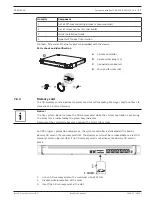
PRAESENSA
From installation to configuration | en
49
Bosch Security Systems B.V.
Installation manual
2019.11 | V1.00 |
6.3
Network connections to devices
Except for some accessories, PRAESENSA devices must be connected to the OMNEO network
in order to become part of the PA/VA system. Depending on the size of the system, there are
different ways to do that.
6.3.1
Star topology
In this topology, the system controller is the central point and other devices are connected
directly to one of the ports of the system controller. But, because the system controller has
five ports, the system can only be very small. No call station can be connected because the
system controller does not have ports that supply PoE.
Many wired home networks are wired like this with one central multi‑port switch as central
point. However, for a sound system this is not very useful.
6.3.2
Tree topology
A tree or ‘combined star’ topology is effectively an interconnection of multiple star networks.
In modern networks this is the most used topology. In this topology the connection of devices
depend on the connection of other devices in the network.
All PRAESENSA networked devices have a built‑in Ethernet switch and at least two ports.
Because of this, devices can easily be connected to a switch port of another device. Devices
are then cascaded or looped through.
The system controller is still the central point of the network. A multifunction power supply is
connected to one port of the system controller. A call station can be connected to a port of
the multifunction power supply that provides PoE. An amplifier can be connected to another
port of the system controller, but also to one of the ports of the multifunction power supply.
Another amplifier can be connected to the first amplifier, and so on.
For every three amplifiers, a multifunction power supply is needed, which has a multi‑port
switch built in. So the connection possibilities grow with the system size. Not all devices need
to be looped through in a single long string of devices, but parallel paths (branches) of shorter
strings are possible. The use of branches reduces the risk that a failing connection of a
devices close to the root of the tree disconnects all other devices. Still a single connection
failure may cause more than one device to become disconnected from the system controller.
And even though an amplifier might be connected to a call station, when both get
disconnected from the system controller, the audio connection between the call station and
the amplifier gets lost. The system controller is needed to set up and supervise the
connections.
6.3.3
Ring topology
A next step in improving the connectivity of the devices is to use a ring topology. In this
topology the devices are connected in one or more rings or closed loops. Normal Ethernet
networks do not allow a topology with more than one physical path between two endpoints
(e.g. multiple connections between two network switches or two ports on the same switch
connected to each other). The loop creates broadcast storms as broadcasts and multicasts
are forwarded by switches out of every port. The switch or switches will repeatedly
rebroadcast the broadcast messages, flooding the network.
A physical topology that contains switching or bridge loops is attractive for redundancy
reasons, yet a switched network must not have loops. The solution is to allow physical loops,
but create a loop-free logical topology using a protocol that disables redundant connections
until they are needed because another connection failed. RSTP is such a protocol and all
Summary of Contents for PRAESENSA
Page 1: ...PRAESENSA Public Address and Voice Alarm System en Installation manual ...
Page 2: ......
Page 193: ......















































